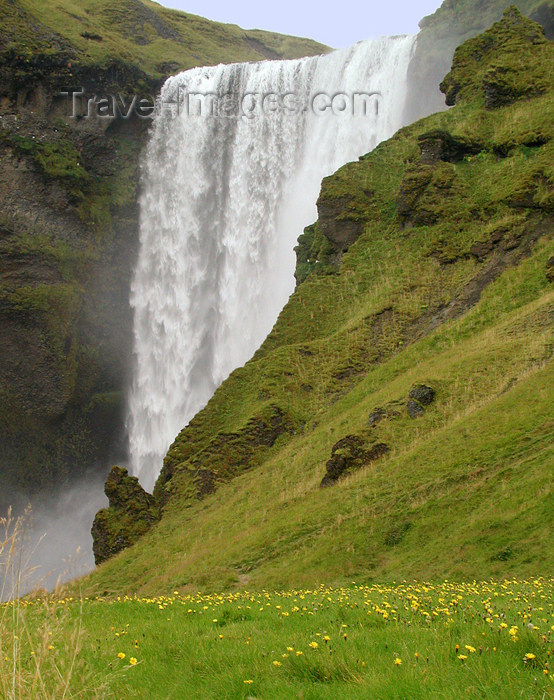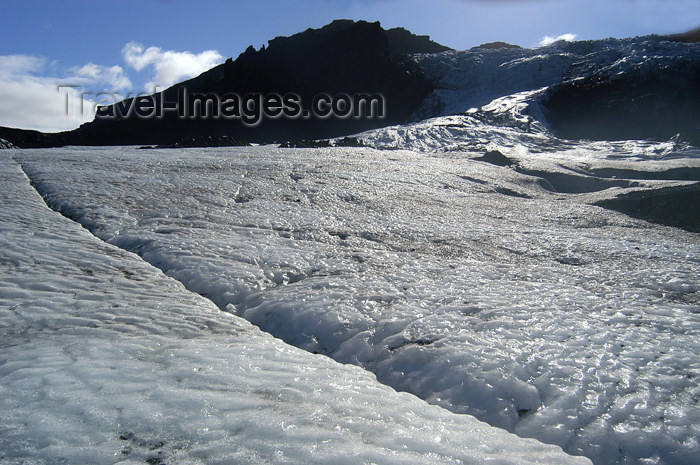 “Fossing”
Through Iceland
“Fossing”
Through Iceland
Waterfalls & Glaciers
by Bill Cain
| Travel Articles for Publishers |
Travel-Images.com
|
 “Fossing”
Through Iceland
“Fossing”
Through Iceland
Waterfalls & Glaciers
by Bill Cain
I remember visiting Sabaday Falls on New Hampshire’s Kancamagus Highway in the early 1960’s as a youth. At that time, a hard-to-find trail led to the falls. After hiking in, you could pick your way through the forest, walk right up to the falls and frolic in them if you wanted. Sadly, those days are long gone. Today, beneath a prominent road sign, a finely groomed path leads to a cordoned off viewing area beyond which is off limits.
If that same waterfall were in Iceland, visitors today would have the freedom to enjoy a close encounter with it, much as they would have done some 45 years ago in New Hampshire. That’s partly because of the sparse population, but mostly because waterfalls in Iceland are about as common as traffic lights in the center of Manchester – just around the corner you’re likely to bump into another one.
There are literally thousands of waterfalls in Iceland and they are right at home with glaciers, hot springs geysers, active volcanoes and other forces of nature found in abundance here. The waterfalls range from thundering torrents to gentle cascades and have become one of the primary reasons people travel to Iceland.
In the southern part of the country, where I visited recently, there is a large concentration of falls due primarily to the close proximity of the island’s main glaciers. And, unlike in New England, where dry summers usually result in low water levels by September, the warmer summer months in Iceland accelerate glacial runoff and by the end of the tourist season in September the waterfalls are gushing.
Due to the virtual absence of trees in
Iceland, many waterfalls can be seen from great distances along the main
ring road around the perimeter of the island. Most are small and unnamed.
Many appear to be in people’s backyards, and I was told that local farmers
have harnessed some for their personal energy needs.
Gullfoss is one of Iceland’s largest waterfalls and, because Reykjavik the capital is nearby, is probably visited by more tourists that any other waterfall. It’s one of the premier attractions for tour bus groups, which do day-long loops through the area just east of the city. There are handrail restraints at this waterfall to keep visitors from falling in to the dangerous fast flowing rapids at the head. The timing of my visit here coincided with on and off rain showers, which helped produce several brilliant rainbows over the falls.
Seljalandsfoss, which can be seen when traveling the ring road, is a beautiful tall and slender waterfall and perhaps Iceland’s most photographed. The interesting feature of Seljalandsfoss is that it can be viewed from the rear. A well-worn footpath meanders behind the falling water for those who are appropriately attired and don’t mind a drenching.
Skogafoss is just half an hour further down the ring road. A wide, 180-foot direct drop, it has a steep footpath up one side, where visitors can get different views at various heights. The force of the water at the bottom kicks up such a strong wind and spray that it kept even me from getting too close.
Svartifoss, or the black waterfall, requires a short hike in Skaftifell National Park. Its name is not derived from the color of the water, but from the enormous columns of black basalt rock that surround the falls. These columns were the inspiration for the contemporary architectural design of the Icelandic National Theater built in 1930 in Reykjavik.
Finally, on my way back to Reykvavik, I explored Oxararfoss in Pingvellier National Park. Here it’s possible to walk right up to the lip of the drop and also to get as wet as you want at the base.
All the waterfalls in Iceland are unique
in their own ways, and the almost unlimited access to most of them provide
refreshing respites for anyone traveling through this enchanting country.
Just remember to pack your foul weather gear for close-up viewing.
Iceland’s Frozen H2O
Because of the inherent danger of moving about on the surface of any glacier, travel on Vatnajokull is limited to either scientific or commercial excursions. Fortunately, for the uninitiated, a glacial expedition tour operation called Joklaferoir takes small groups on three to four hour “glacier tours” during the summer months of late May through mid-September.
The tours begin just off Iceland’s ring road between the villages of Skaftifell and Hofn with a harrowing 10-mile 4-wheel drive trip through spectacular mountain scenery. At a remote mountain hut, tourists are outfitted for the icecap experience with snowmobile suits, helmets and other cold weather gear. Early in the season, when the snow pack stretches from the glacier to the hut, the 4-wheel drive part of the tour ends at the hut. However, in September, when the snow pack has long since receded, getting onto the glacier requires an additional drive, but only after the 4-wheel drive vehicles have had their tires deflated to provide traction.
 After
driving onto the ice, tour participants are transferred to a thiokul, or
glacier buggy, which resembles a tourist-friendly version of a small tank.
Crawling slowly on its treads over crevasses to risky for any land-based
vehicle to attempt, it reaches the next pit stop, where the snowmobiles
are waiting. After a brief orientation, we set off to explore a small portion
of Vatnajokull’s vast interior for the next hour or so.
After
driving onto the ice, tour participants are transferred to a thiokul, or
glacier buggy, which resembles a tourist-friendly version of a small tank.
Crawling slowly on its treads over crevasses to risky for any land-based
vehicle to attempt, it reaches the next pit stop, where the snowmobiles
are waiting. After a brief orientation, we set off to explore a small portion
of Vatnajokull’s vast interior for the next hour or so.
Though much of Vatnajokull is completely flat, white and devoid of any detail, the area traversed on the tour is relatively close to the edge of the glacier where the surface is undulating and spiked with outcroppings of black basalt rock, providing eerie and surreal landscape scenery in black & white tones. On the particular day of my tour, broken clouds and snow flurries complimented the moody atmosphere.
The glacier tours are not inexpensive (about
$125. per person), but they have become quite popular in the few months
of the year during which they are offered. Reservations are recommended
and additional information is available on the Internet at www.glaciertours.is.
| see also: travel articles, images, about us, photographers |
|
|
|
|
|
|
|
|
|
|
| Travel Articles |
www.travel-images.com
|